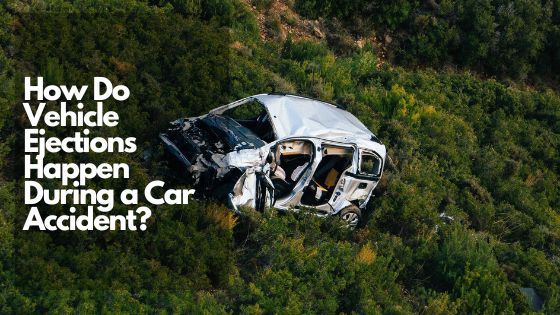An ejection accident puts victims at an increased risk since they can be run over by oncoming vehicles. A vehicle ejection occurs when a passenger is thrown out of a car after a collision. Victims can often sustain serious injuries during these precarious situations.
In order to win the award or settlement you rightfully deserve after such an incident, it’s best to have an experienced car accident attorney on your side. Expert legal advice will help you navigate litigation and land the most favorable outcome.
Factors Affecting the Gravity of Car Ejection Injuries
The National Highway Traffic Safety Administration (NHTSA) reports that 83 percent of vehicle ejection victims lose their lives because of sustained injuries. However, vehicle occupants who use seat belts reduce their risk of critical injury by 50 percent.
Various factors can influence the severity of injuries one can sustain during a vehicle ejection. For example, the speed of the vehicle involved has a direct effect on the impact during a collision. The weight of the vehicles also adds to the potential traumatic force an accident victim can experience. Further, the angle of the collision can also play a role in whether a person could survive such an accident or not.
In most cases, any person getting ejected from a vehicle can either be severely injured or injured fatally.
Types of Injuries Car Ejection Victims Can Sustain
An experienced vehicle accident lawyer will ascertain the injuries a victim has sustained in these severe car crash cases. Vehicle ejection accidents can cause injuries to several critical body parts:
- Soft tissues
- Brain and/or skull
- Internal organs
- Neck
- Spinal cord
- Bones and joints
Apart from direct injuries from the car crash, victims may also suffer from suffocation, getting pinned by debris or being run over by other vehicles not directly involved in the accident.
How a Vehicle Ejection Can Happen
Vehicle ejections can cause passengers to be thrown out through a windshield, window or door during a collision. A car accident attorney will determine all the details of the collision to build your case. In most cases, the victim was likely not wearing a seatbelt during the accident.
Some of the most common causes of a potential car ejection include defective seat belts, malfunctioning door latches, weak car window glass and defective car roofs or sunroofs.
The following are some of the other potential causes:
- Vehicle rollovers: The risk of being ejected from a vehicle increases during a rollover. SUVs and larger vehicles are more prone to rollovers. Many car owners believe that the larger vehicle provides them more protection. However, the higher center of gravity and larger SUV loads contribute to a potential vehicle rollover during a collision.
- Rear end collisions: The force generated by a vehicle slamming at the back of another can be enough to cause passengers to fly through the windshield or a car window.
- Single vehicle accident: Some vehicle ejection accidents occur when a car hits a guard rail, a tree, a lamp post, a utility pole, a wall or even another parked vehicle. If the car went too fast, the impact could be enough to eject passengers.
- Multiple vehicle accidents: Multi-vehicle accidents are extremely dangerous and can potentially cause more car ejections. The force generated by multiple cars ramming other vehicles can be transferred to people occupying their cars, causing them to get thrown out and sustaining multiple injuries.
A car accident attorney will look into these details to determine which driver was at fault. The severity of the injuries, the medical costs and the property damage will be accounted for when submitting insurance claims. These details can also be used in court if the situation warrants it.
Types of Vehicle Ejections
Vehicle ejection accidents can be classified under two categories:
- Partial Ejection
During a partial ejection, the vehicle occupant may have been by car safety equipment, such as a seatbelt or airbags. In such cases, the accident victim wasn’t thrown out of the vehicle. The window, seatbelt or windshield often prevented the person from forcibly exiting the vehicle. However, a partial ejection can still cause trauma and other serious injuries.
- Total Ejection
A total ejection occurs when a vehicle occupant is thrown out completely from a vehicle upon impact. A total ejection is more dangerous than a partial ejection as the victim can land on or hit another object or vehicle. In many instances, a total ejection has led to the wrongful death of an individual.
What To Do if One Is Seriously Injured in a Vehicle Ejection?
It’s best to retain the services of an experienced vehicle accident lawyer if you or a loved one has been seriously injured in a vehicle ejection. If the vehicle accident has resulted in the death of a loved one, you should file a wrongful death suit. Your attorney will help you retrieve the monetary compensation you deserve for all types of damages associated with the car crash.
Work with your lawyer to build your case by determining the crucial factors that contributed to the incident:
- Tire blowouts
- The driver at fault was under the influence or distracted
- Failed safety equipment such as airbags and seatbelts
- The other driver was driving too aggressively
A seasoned car accident attorney will work on your behalf and handle all aspects of your case. This service includes negotiating with the insurance company of the driver at fault.
Call the Law Offices of David Kohm today at any of our convenient locations and get a free consultation.
Arlington (817) 522-4451
Dallas (972) 362-6848
Fort Worth (817) 764-1375
Plano (972) 354-4602
Cedar Hill (972) 338-9427
McKinney (469) 522-3688
Lewisville (972) 354-4605
Frisco (972) 725-7681
Grapevine (817) 835-8677
Irving (972) 354-4610
Keller (817) 204-0904
Garland (214) 572-2251
Denton (940) 222-4060
Addison (972) 564-8108
You can also contact us online by using our quick contact form.











